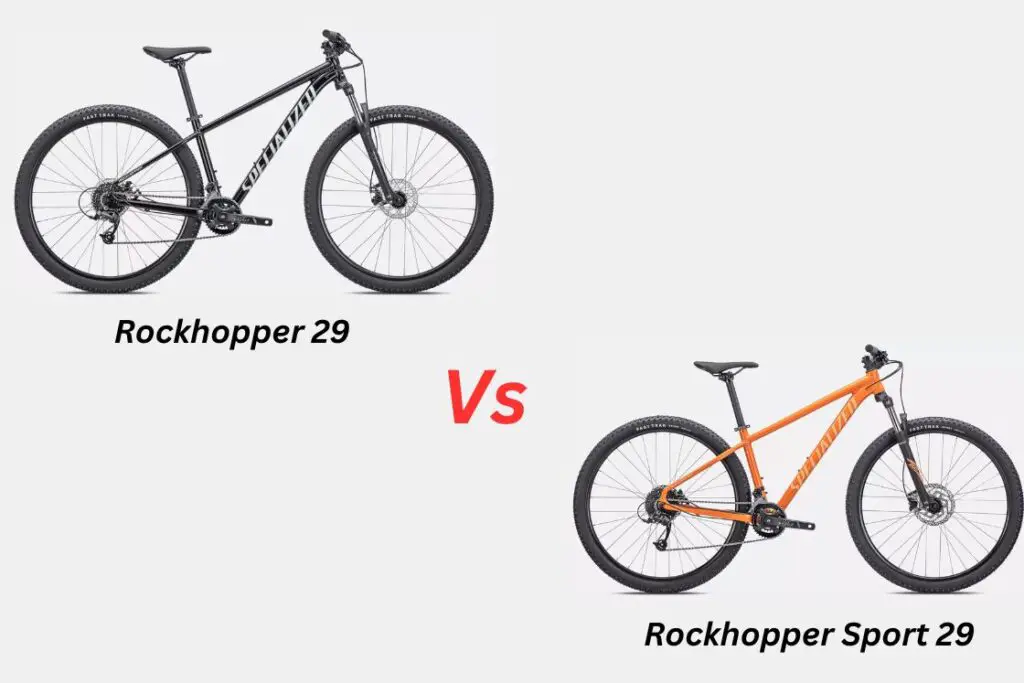
If you are looking for an entry-level mountain bike that can handle a variety of trails, you might be interested in the Specialized Rockhopper 29 and the Rockhopper Sport 29.
These are both 29″ aluminum frame hardtail crosscountry bikes that offer a lot of value for your money. But what are the differences between them and which one should you choose?
Here, we will compare and contrast the main features and components of these two bikes and help you decide which one suits your riding style and budget better.
Quick Comparison
| Feature/Difference | Rockhopper 29 | Rockhopper Sport 29 |
|---|---|---|
| Fork | SR Suntour XCE 28 with coil spring and 80/90/100mm travel (depending on frame size) | SR Suntour XCM with air spring and 100mm travel |
| Brakes | Mechanical disc brakes with 160mm rotors | Hydraulic disc brakes with 180/160mm rotors |
| Drivetrain | 2×8 drivetrain with Shimano Altus and microSHIFT components | 1×9 drivetrain with microSHIFT Advent components |
| Tires | Specialized Ground Control Sport (29×2.3″) | Specialized Fast Trak Sport (29×2.3″) |
Detailed Comparison
The Rockhopper 29 is the base model of the Rockhopper series, and it costs $700. The Rockhopper Sport 29 is one step up from the base model, and it costs $800.
Both bikes have the same frame geometry and size options, but they differ in some key aspects, such as the fork, the brakes, the drivetrain, and the tires.
Fork
The fork is one of the most important parts of a mountain bike, as it affects the handling, comfort, and performance of the bike on different terrains.
The Rockhopper 29 has a SR Suntour XCE 28 fork with 80/90/100mm of travel (depending on frame size) and a coil spring. The Rockhopper Sport 29 has a SR Suntour XCM fork with 100mm of travel and an air spring.
The air spring is lighter, more adjustable, and more responsive than the coil spring, so it offers a better ride quality and performance.
The XCM fork also has a lockout feature that allows you to lock the fork for more efficiency on smooth surfaces.
Read Also: Rockhopper Elite vs. Expert: Which One Should You Buy?
Brakes
The brakes are another crucial component of a mountain bike, as they provide the stopping power and control you need on steep descents and tight corners.
The Rockhopper 29 has mechanical disc brakes with 160mm rotors, while the Rockhopper Sport 29 has hydraulic disc brakes with 180/160mm rotors.
Hydraulic disc brakes are more powerful, reliable, and consistent than mechanical disc brakes, especially in wet or muddy conditions.
They also require less maintenance and adjustment than mechanical disc brakes. The larger front rotor on the Rockhopper Sport 29 also provides more braking force and heat dissipation.
Drivetrain
The drivetrain is the system that transfers your pedaling power to the rear wheel, and it consists of the chainring(s), cassette, chain, derailleur(s), and shifter(s).
The Rockhopper 29 has a 2×8 drivetrain with a Shimano Altus rear derailleur and shifter, a microSHIFT front derailleur and shifter, a SunRace cassette (11-34t), and a Stout crankset (36/22t).
The Rockhopper Sport 29 has a 1×9 drivetrain with a microSHIFT Advent rear derailleur and shifter, a SunRace cassette (11-42t), and a Stout crankset (30t).
A 1×9 drivetrain is simpler, lighter, and more reliable than a 2×8 drivetrain, as it eliminates the front derailleur and shifter and reduces the chances of chain drops and shifting issues.
A 1×9 drivetrain also offers a wider gear range than a 2×8 drivetrain, as it has a larger cassette that can handle steeper climbs and faster descents.
Read Also: Trek Marlin 5 vs. Co-op DRT 1.1: which one is better?
Tires
The tires are the contact points between your bike and the ground, and they affect the traction, grip, rolling resistance, and comfort of your ride.
The Rockhopper 29 has Ground Control Sport tires (29×2.3″), while the Rockhopper Sport 29 has Fast Trak Sport tires (29×2.3″).
Both tires are made by Specialized and have similar widths, but they have different tread patterns and rubber compounds.
The Ground Control Sport tires have more aggressive knobs that provide better traction and grip on loose or rough terrain, while the Fast Trak Sport tires have more low-profile knobs that provide lower rolling resistance and faster speed on hardpack or smooth terrain.
So which bike should you choose?
It depends on your personal preference, riding style, and budget.
If you are looking for a more affordable bike that can handle moderate trails with ease, you might prefer the Rockhopper 29.
If you are looking for a more capable bike that can tackle more challenging trails with confidence, you might prefer the Rockhopper Sport 29.
Either way, you will get a quality bike that will give you hours of fun on the trails.
